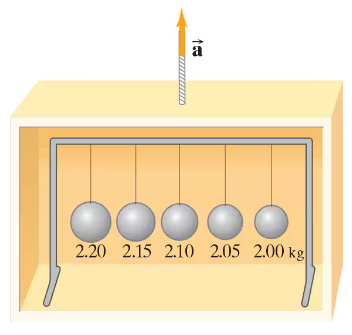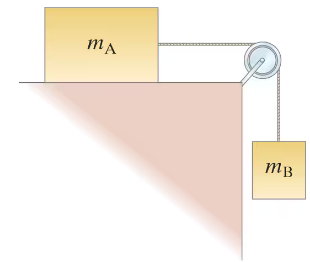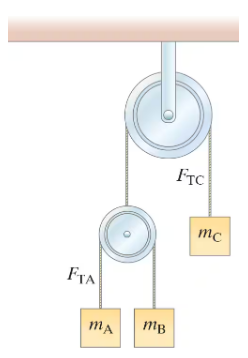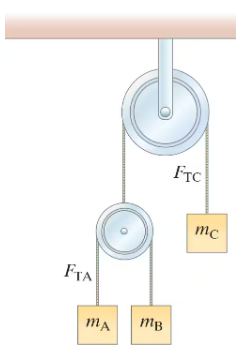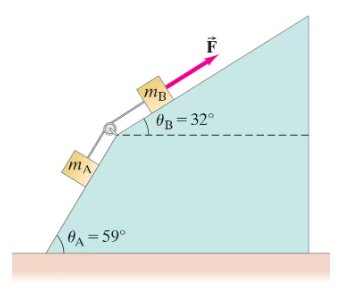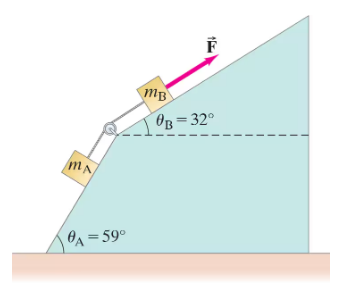 Back
BackProblem 4.82c
A 6750-kg helicopter accelerates upward at 0.80m/s² while lifting a 1080-kg frame at a construction site, Fig. 4–66.
<IMAGE>
(c) What force does the cable exert on the helicopter?
Problem 6
According to a simplified model of a mammalian heart, at each pulse approximately 20 g of blood is accelerated from 0.25 m/s to 0.35 m/s during a period of 0.10 s. What is the magnitude of the force exerted by the heart muscle?
Problem 7
Superman must stop a 120-km/h train in 150 m to keep it from hitting a stalled car on the tracks. If the train's mass is 3.6 x 10⁵ kg, how much force must he exert? Compare to the weight of the train (give as %). How much force does the train exert on Superman?
Problem 16
A 75-kg petty thief wants to escape from a third-story jail window. Unfortunately, a makeshift rope made of sheets tied together can support a mass of only 62 kg. How might the thief use this 'rope' to escape? Give a quantitative answer.
Problem 40a
At the instant a race began, a 65-kg sprinter exerted a force of 720 N on the starting block at a 22° angle with respect to the ground. What was the horizontal acceleration of the sprinter?
Problem 40b
At the instant a race began, a 65-kg sprinter exerted a force of 720 N on the starting block at a 22° angle with respect to the ground. If the force was exerted for 0.32 s, with what speed did the sprinter leave the starting block?
Problem 43a
A 27-kg chandelier hangs from a ceiling on a vertical 3.4-m-long wire. What horizontal force would be necessary to displace its position 0.15 m to one side?
Problem 43b
A 27-kg chandelier hangs from a ceiling on a vertical 3.4-m-long wire. What will be the tension in the wire?
Problem 47
An object is hanging by a string from your rearview mirror. While you are accelerating at a constant rate from rest to 28 m/s in 5.0 s, what angle θ does the string make with the vertical? See Fig. 4–46.
Problem 50
As shown in Fig. 4–48, five balls (masses 2.00, 2.05, 2.10, 2.15, 2.20 kg) hang from a crossbar. Each mass is supported by '5-lb test' fishing line which will break when its tension force exceeds 22.2 N (5.00lb). When this device is placed in an elevator, which accelerates upward, only the lines attached to the 2.05 and 2.00 kg masses do not break. Within what range is the elevator's acceleration?
Problem 57
Determine a formula for the acceleration of the system shown in Fig. 4–49 (see Problem 55) if the cord has a non-negligible mass mC. Specify in terms of ℓA and ℓB , the lengths of cord from the respective masses to the pulley. (The total cord length is ℓA + ℓB.)
Problem 63a
The double Atwood machine shown in Fig. 4–55 has frictionless, massless pulleys and cords. Determine the acceleration of masses mA, mB, and mC.
Problem 63b
The double Atwood machine shown in Fig. 4–55 has frictionless, massless pulleys and cords. Determine the tensions FTA and FTC in the cords.
Problem 86
Three mountain climbers who are roped together in a line are ascending an icefield inclined at 29° to the horizontal (Fig. 4–67). The last climber slips, pulling the second climber off his feet. The first climber is able to hold them both. If each climber has a mass of 75 kg, calculate the tension in each of the two sections of rope between the three climbers. Ignore friction between the ice and the fallen climbers.
<IMAGE>
Problem 88a
Consider the system shown in Fig. 4–68 with mA = 8.2kg and mB = 11.5kg. The angles θA = 59° and θB = 32°. In the absence of friction, what force would be required to pull the masses at a constant velocity up the fixed inclines?
Problem 88c
Consider the system shown in Fig. 4–68 with mA = 8.2kg and mB = 11.5kg. The angles θA = 59° and θB = 32°. In the absence of , what is the tension in the string?


